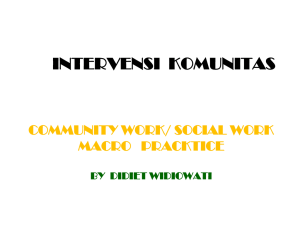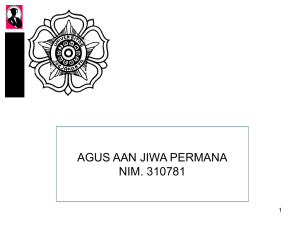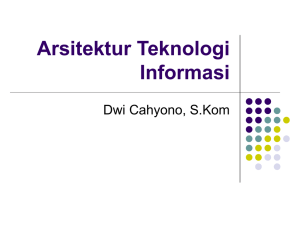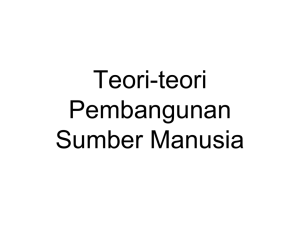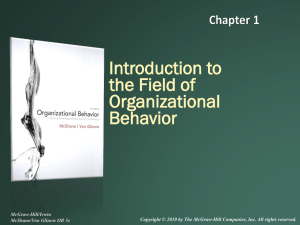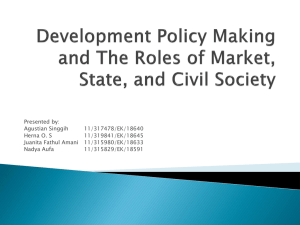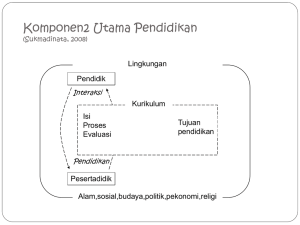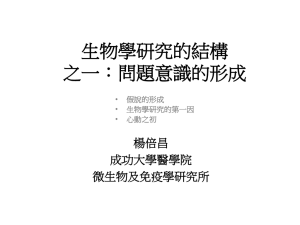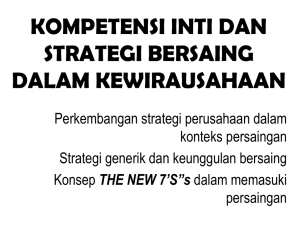BAB 7 - Simponi
advertisement
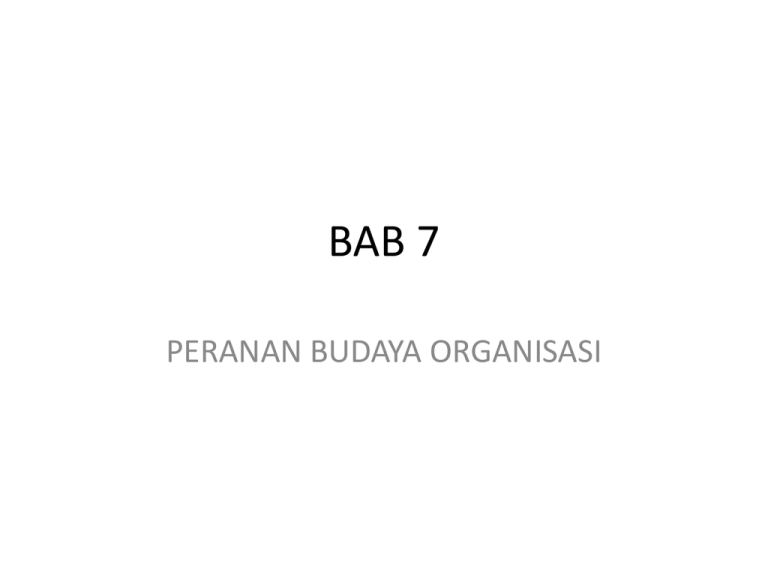
BAB 7 PERANAN BUDAYA ORGANISASI PENDAHULUAN As the soil, however rich it may be, cannot be productive without cultivation, so the mind without culture can never produce good fruit. Seneca (Roman Senator, c. 60 b.c.–c. a.d. 37) PENDAHULUAN Effective Knowledge Management •80% -Organizational culture and human factors •20% -Technology PENDAHULUAN Lingkungan budaya organisasi memiliki peran penting dalam menentukan apakah yang terjadi terhadap manajemen pengetahuan di dalam organisasi tersebut. PENDAHULUAN Dalam istilah antropologi, budaya merujuk pada nilai-nilai, kepercayaan dan kode praktis yang mendasari yang membentuk suatu komunitas. Contoh : kebiasaan masyarakat, self-image/ citra diri anggotaanggotanya, dan hal-hal yang membuatnya berbeda dari masyarakat lain adalah budaya. PENDAHULUAN Media budaya adalah interaksi sosial, jaringan komunikasi yang membentuk komunitas. Beberapa pengertian budaya organisasi : (1) Morgan (1977),culture as “an active living phenomenon through which people jointly create and recreate the worlds in which they live” (p. 141). For Morgan, the three basic questions cultural analysts must answer are: 1. What are the shared frames of reference that make organization possible? 2. Where do they come from? 3. How are they created, communicated, and sustained? PENDAHULUAN (2) Schein (1999), “organizational culture is a pattern of basic assumptions—invented, discovered, or developed by a given group as it learns to cope with its problems of external adaptation and internal integration—that has worked well enough to be considered valid and, therefore, to be taught to new members as the correct way to perceive, think and feel in relation to those problems” (p. 385). PENDAHULUAN Morgan (1977) found that some key elements of organizational culture include: 1. Stated and unstated values. 2. Overt and implicit expectations for member behavior. 3. Customs and rituals. 4. Stories and myths about the history of the group. 5. Shop talk—typical language used in and about the group. 6. Climate—the feelings evoked by the way members interact with one another,with outsiders, and with their environment, including the physical space they occupy. 7. Metaphors and symbols—may be unconscious or embodied in other cultural elements. PENDAHULUAN Although every organization has its own culture, strong or weak, most organizations do not create their culture consciously. Culture is created and ingrained into people’s lives unconsciously. Organizational culture, therefore, may be thought of as the manner in which an organization solves problems to achieve its specific goals and to maintain itself over time. Moreover, it is holistic, historically determined, socially constructed, and difficult to change (Hofstede et al., 1990). DIFFERENT TYPES OF CULTURES Goffee and Johns (2000), for example, identified four types of organizational culture, which they created by using two dimensions. The first dimension, sociability, is a measure for friendliness. A high sociable culture indicates that people within the culture tend to be friendly to each other without expecting something in return. Sociability is consistent with a high people orientation, high team orientation, and focus on process rather than outcomes. Solidarity, the second dimension, measures the task orientation. High solidarity means that people can work well together toward common goals, even when they have personal disputes or conflicts. This classification scheme produces four types of organizational cultures: communal, networked, mercenary, and fragmented (see Table 7-1). A communal culture can give its members a sense of belonging, though it also is taskdriven. Leaders of this culture are usually very inspirational and charismatic. The major negative is that they often exert too much influence and other members are rarely vocal. In a networked culture, members are treated as friends and family. People have close contact with each other and love each other. They are willing to help each other and share information. The disadvantage of this culture is that people are so kind to each other that they are reluctant to point out and criticize the poor performance. A mercenary culture focuses on strict goals. Members are expected to meet the goals and to get the job done quickly. Since everyone focuses on goals and objectivity, there is little room for political cliques. The negative is that those with poor performance may be treated inhumanely. In a fragmented culture, the sense of belonging to and identification with the organization is usually very weak. The individualists constitute the organizations, and their commitment is given first to individual members and task work. The downside is that there is a lack of cooperation. In summary, organizational culture : 1. Establishes a set of roles (social identities). 2. Establishes a set of role expectations (traits, competencies, and values) associated with each identity. 3. Establishes the status or value/worth to the reference group of each social identity. 4. Provides values, cognitive schema, and mental models to influence how individuals behave with respect to the various groups or communities they find themselves a member of (microculture), as well as with respect to the organizational culture as a whole. CULTURAL TRANSFORMATION TO A KNOWLEDGE-SHARING CULTURE How is culture developed, reinforced, and changed? It is often said in organizations that “we need to change the culture around here.” What is usually meant is that someone desires a behavioral change, such as employees paying more attention to customers, or that they want managers to come to meetings on time, or some other set of behaviors. CULTURAL TRANSFORMATION TO A KNOWLEDGE-SHARING CULTURE Virtual organizations face additional challenges such as: • No formalization, with each organization following its own norms, styles, and ideas. • No shared values, beliefs, ideas, or norms. • No frameworks or policies that guide individuals working in the organization. The communication between the members of virtual organizations is so limited and is conducted through channels so impersonal (the computer) that the scope for developing a shared sense of belonging or a climate in the organization is almost nonexistent. The following are some recommendations for bringing about the cultural change needed for KM to succeed: 1. Clearly define desired cultural outcomes. 2. Assess the current cultural state. 3. Diagnose the existing culture with respect to desired knowledge-sharing behaviors. 4. Assess tolerance to change. 5. Identify change enablers and barriers. 6. Assess the maturity level of KM within the organization. 7. Identify KM enablers and barriers. 8. Conduct a gap analysis to yield a map on how to get from where the organization is currently to where it would like to be culturally.

